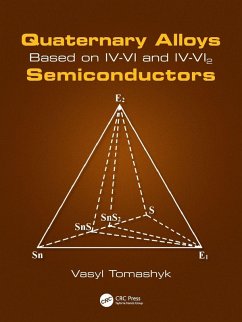Vasyl Tomashyk
Quaternary Alloys Based on IV-VI and IV-VI2 Semiconductors
Vasyl Tomashyk
Quaternary Alloys Based on IV-VI and IV-VI2 Semiconductors
- Broschiertes Buch
- Merkliste
- Auf die Merkliste
- Bewerten Bewerten
- Teilen
- Produkt teilen
- Produkterinnerung
- Produkterinnerung
This book will be of interest to undergraduate and graduate students studying materials science, solid state chemistry, and engineering.
This book will be of interest to undergraduate and graduate students studying materials science, solid state chemistry, and engineering.
Produktdetails
- Produktdetails
- Verlag: CRC Press
- Seitenzahl: 534
- Erscheinungstermin: 30. Januar 2025
- Englisch
- Abmessung: 280mm x 210mm x 29mm
- Gewicht: 1290g
- ISBN-13: 9780367642211
- ISBN-10: 0367642212
- Artikelnr.: 72542970
- Herstellerkennzeichnung
- Libri GmbH
- Europaallee 1
- 36244 Bad Hersfeld
- gpsr@libri.de
- Verlag: CRC Press
- Seitenzahl: 534
- Erscheinungstermin: 30. Januar 2025
- Englisch
- Abmessung: 280mm x 210mm x 29mm
- Gewicht: 1290g
- ISBN-13: 9780367642211
- ISBN-10: 0367642212
- Artikelnr.: 72542970
- Herstellerkennzeichnung
- Libri GmbH
- Europaallee 1
- 36244 Bad Hersfeld
- gpsr@libri.de
Vasyl Tomashyk is a leading researcher at the V.Ye. Lashkaryov Institute for Semiconductor Physics of the National Academy of Sciences of Ukraine. After graduating from Chernivtsi State University in 1972 (master of chemistry), he became a doctor of chemical sciences (1992), professor (1999), and author of about 690 publications in scientific journals and conference proceedings, including 12 books (seven of which are published by CRC Press) devoted to physical-chemical analysis, chemistry of semiconductors, and chemical treatment of semiconductor surfaces. Prof. Tomashyk is a specialist at a high international level in the field of solid-state and semiconductor chemistry, including physical-chemical analysis and the technology of semiconductor materials. He was head of research topics within the international program "Copernicus". He is a member of the Materials Science International Team (Stuttgart, Germany, since 1999), which prepares a series of prestigious reference books under the titles of Ternary Alloys and Binary Alloys, and has had 35 articles published in the Landolt-Börnstein New Series. Prof. Tomashyk actively works with young researchers and graduate students and 22 Ph.D. theses have been prepared under his supervision. For many years, he has been a professor at Ivan Franko Zhytomyr State University.
Chapter 1: Systems based on silicon sulfides. Chapter 2: Systems based on
silicon selenides. Chapter 3: Systems based on silicon telluride. Chapter
4: Systems based on germanium sulfides. Chapter 5: Systems based on
germanium selenides. Chapter 6: Systems based on germanium telluride.
Chapter 7: Systems based on tin sulfides. Chapter 8: Systems based on tin
selenides. Chapter 9: Systems based on tin telluride. Chapter 10: Systems
based on lead sulfide. Chapter 11: Systems based on lead selenide. Chapter
12: Systems based on lead telluride. References.
silicon selenides. Chapter 3: Systems based on silicon telluride. Chapter
4: Systems based on germanium sulfides. Chapter 5: Systems based on
germanium selenides. Chapter 6: Systems based on germanium telluride.
Chapter 7: Systems based on tin sulfides. Chapter 8: Systems based on tin
selenides. Chapter 9: Systems based on tin telluride. Chapter 10: Systems
based on lead sulfide. Chapter 11: Systems based on lead selenide. Chapter
12: Systems based on lead telluride. References.
Chapter 1: Systems based on silicon sulfides. Chapter 2: Systems based on silicon selenides. Chapter 3: Systems based on silicon telluride. Chapter 4: Systems based on germanium sulfides. Chapter 5: Systems based on germanium selenides. Chapter 6: Systems based on germanium telluride. Chapter 7: Systems based on tin sulfides. Chapter 8: Systems based on tin selenides. Chapter 9: Systems based on tin telluride. Chapter 10: Systems based on lead sulfide. Chapter 11: Systems based on lead selenide. Chapter 12: Systems based on lead telluride. References.
Chapter 1: Systems based on silicon sulfides. Chapter 2: Systems based on
silicon selenides. Chapter 3: Systems based on silicon telluride. Chapter
4: Systems based on germanium sulfides. Chapter 5: Systems based on
germanium selenides. Chapter 6: Systems based on germanium telluride.
Chapter 7: Systems based on tin sulfides. Chapter 8: Systems based on tin
selenides. Chapter 9: Systems based on tin telluride. Chapter 10: Systems
based on lead sulfide. Chapter 11: Systems based on lead selenide. Chapter
12: Systems based on lead telluride. References.
silicon selenides. Chapter 3: Systems based on silicon telluride. Chapter
4: Systems based on germanium sulfides. Chapter 5: Systems based on
germanium selenides. Chapter 6: Systems based on germanium telluride.
Chapter 7: Systems based on tin sulfides. Chapter 8: Systems based on tin
selenides. Chapter 9: Systems based on tin telluride. Chapter 10: Systems
based on lead sulfide. Chapter 11: Systems based on lead selenide. Chapter
12: Systems based on lead telluride. References.
Chapter 1: Systems based on silicon sulfides. Chapter 2: Systems based on silicon selenides. Chapter 3: Systems based on silicon telluride. Chapter 4: Systems based on germanium sulfides. Chapter 5: Systems based on germanium selenides. Chapter 6: Systems based on germanium telluride. Chapter 7: Systems based on tin sulfides. Chapter 8: Systems based on tin selenides. Chapter 9: Systems based on tin telluride. Chapter 10: Systems based on lead sulfide. Chapter 11: Systems based on lead selenide. Chapter 12: Systems based on lead telluride. References.


